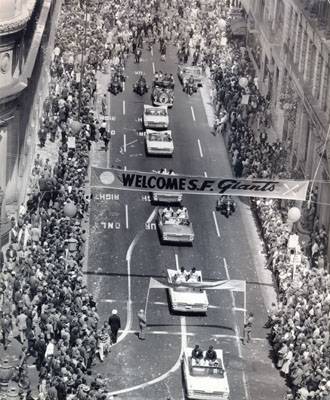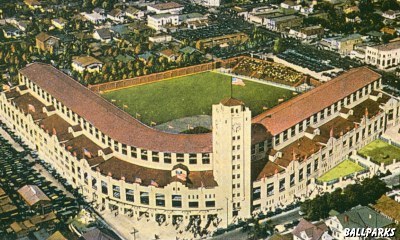
Wilson has the sign. He winds and fires..fastball..HE STRUCK HIM OUT! TEIXEIRA HAS STRUCK OUT AND THE GIANTS ARE WORLD CHAMPIONS OF BASEBALL FOR 2010! The Giants have won their first World Series since 1954 and their first World Series in San Francisco. They are mobbing Brian Wilson on the mound and listen to these 43,000 fans cheer! – Jon Miller
Wilson delivers..STRIKE THREE AND THE GIANTS HAVE WON! THE GIANTS ARE THE WORLD CHAMPIONS! (Woohoo! – Mike Krukow) The Giants have done it! – Duane Kuiper
I’ve never seen the Giants win the World Series and so I wonder what it’s like, sometimes watching baseball, sometimes throwing the wiffle ball in the backyard (conveniently I have changed my name to my mother’s maiden name, which just happens to also be Wilson) and sometimes while stuck in public transport (the daydreamer’s equivalent of a Buddhist monastery). I’ve seen a favourite baseball team win before; the Red Sox were the previous focus of my imagination, mainly because the Giants’ 50 years seemed so utterly puny compared to the 86 years of emptiness in New England baseball. I attended the 50th anniversary of the 1954 Giants that year and half the team was still alive, including Alvin Dark, Dusty Rhodes, Johnny Antonelli and of course Willie Mays. The reality turned out to be very different to the dream. I was estatic when Foulke tossed Edgar Renteria’s groundball to Mientkiewicz but the real joy had been reserved for the American League Championship Series win the week before. The titanic struggle had vanquished almost every reservation and sense of foreboding a Red Sox fan could have, so by the time the World Series came around I think all Red Sox fans knew that the Cardinals didn’t have a chance, even if the Redbirds had won just 105 games that year. Will a Giants World Series win have that anti-climatic feeling? Doubt it, especially since the Dodgers aren’t going to make the playoffs this year. So, onto my dream...
The Giants became World Champions of baseball after a dramatic seven game upset of the New York Yankees. The highlight was surely game five, where the Giants, down 4-2 in the 8th, rallied to tie the game before Buster Posey hit a 2 run homer off Joba Chamberlain to win 6-4. Tim Lincecum, who had started and won both his games, was named Series MVP. This had capped off a playoffs in which the Giants had been the underdog in every series, beating the two-time pennant winner Phils in four games before breaking Atlanta’s heart, sending Bobby Cox into retirement defeated, beating the Braves in a six game Championship Series that featured three extra-inning games. In the World Series the Giants had lost Game 2 14-3 before Lincecum shut out the Yankees in Game 4, striking out 11 (including Alex Rodriguez 3 times, once with the bases loaded) in a 2-0 shutout. Lincecum returned in Game 7 to give up just 3 hits in 8 innings, gaining the win behind a solitary Pablo Sandoval home run off C.C. Sabathia in the 7th inning. Sandoval had been down 0-2 versus the hefty lefty, whose matchups with Sandoval were dubbed the Sumo Series. But Sabathia had left a fastball over the plate and Sandoval’s drive into the bleachers sparked wild scenes as fans jumped on top of one another in a mixture of joy and a desire to get the ball that put the Giants into the lead.
When the Giants won, pandemonium erupted throughout the Bay Area. In San Francisco, people hugged and kissed complete strangers coming out of snuggeries like Lefty O’Doul’s, Gino and Carlo’s and the Horseshoe. 10,000 fans had turned up to watch the game at the Civic Center and went wild at the win. “I didn’t think I’d ever see them win!,” said one fan. Another yelled out “We’ve finally done it!” before hollering at the top of his lungs indecipherably. A third simply giggled to herself before beginning to cry. Local liquor stores ran out of champagne. San Francisco General Hospital reported three boys had been born that evening and named Tim after the Giants’ star pitcher, while another had been named Pablo Tim Chang. Stockbrokers in the Financial District ran out to the much-loathed Vaillaincourt fountains, dry for almost a decade, and danced in them to the amusement of some homeless nearby, one of whom wore a tattered Giants cap and waved his finger (the index, thankfully) at passersby. In San Jose, fans drove up and down Almaden Boulevard honking horns and shouting “Go Giants!”, with the same also being true in San Mateo by the Caltrain station, which had been painted orange and black for the World Series. San Francisco mayor Gavin Newsom, who had been standing behind managing general partner Bill Neukom when the World Series trophy was presented on the infield at AT&T Park, announced plans for a victory parade starting at the ballpark and going down the Embarcadero and Market Street to the Civic Center on Saturday, November 6. He slurred his announcement slightly, no doubt partaking in some anticipatory victory libations. Hundreds of thousands of fans were expected to attend San Francisco’s first championship since the 49ers won Super Bowl XXIX in 1995 and reports came in that fans from New York (some of whom had seen the last Giant World Series win), Sydney, London and Half Moon Bay were expected to arrive in time for the parade.






